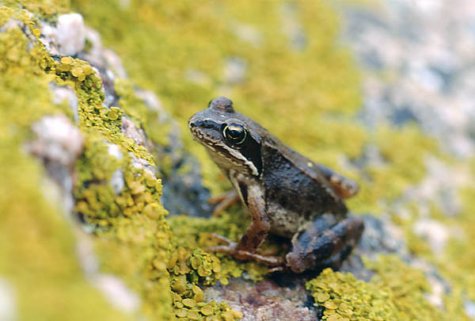July important time for common frogs
Photo Arne Ader
Translation Liis
Common frog on rock
Common frog; European common frog Rohukonn Rana temporaria
In April and early May we helped frogs to cross motor roads. The weather was very variable, occasionally cold and their migration to the spawning waters dragged on.
This is about the common frog because it is the most widely spread and numerous species in Estonia – nine out of ten frogs that you come across are likely to be common frogs. Their colouring may be greenish, brownish or grey, and in rain a specimen coming out from wet grass may look darker. After the spawning they live on land, hidden in daytime, going foraging as dusk falls; in cloudy weather they may wake up in daytime too, to move about.
But we would like to talk about the young, but already metamorphosed generation of frogs who crawl up on land for the first time in July, and whom we can meet in massive numbers. After spawning in April, the development of the tadpoles depends on the temperature of the water body: the spawning occurs in shallow waters of up to 30 centimetres depth that are rapidly warmed by the sun. But still 2-3 months were needed to the metamorphosis. During that time the skeleton and limbs develop. The hormones of the thyroid gland contribute in the metamorphoses of the tadpole; lungs evolve as breathing organs, the gastrointestinal tract develops, skin begins to cover the body. Brain develops; the regression of the tail is slow, a tail is still clearly visible on the frogs-to-be who climb out of the water. Of course the inexperienced individuals have plenty of enemies in that period.
Having grown to a length of about 3 centimetres they go for hibernation for the first time. Development of frogs is slow, they become sexually mature only in their 3rd year of life.









